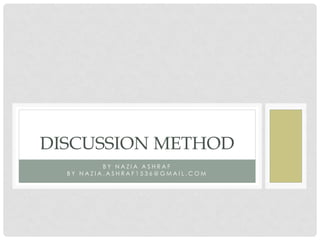
Discussion method
- 1. B Y N A Z I A A S H R A F B Y N A Z I A . A S H R A F 1 5 3 6 @ G M A I L . C O M DISCUSSION METHOD
- 2. DEFINITION "An activity in which people talk together in order to share information a topic or problem or to seek possible available evidence or a. It is used more and more in student-centered learning venues as a means of engaging students in the “active” construction of learning collaboration and the exchange of perspectives”.
- 3. CLASSROOM DISCUSSION “Discussion is thought to be a useful teaching technique for developing higher order thinking skills that enable students to interpret, analyze, and information. Students explain their ideas and thoughts, rather than merely recount, or recite, memorized facts and details. During discussion learners are not passive recipients of information that is transmitted from a teacher. Rather, learners are active participants. Discussion, when combined with probing, open-ended questions, requires students to organize available information for the purpose of arriving at their own defensible answers.”
- 4. CLASSROOM DISCUSSION 1. Task Functions 2. Direction giver 3. Social Functions
- 5. CHARACTERISTICS OF THE DISCUSSION METHOD 1. Experiential Learning 2. Emphasis on Students 3. Focus on Critical Thinking 4. Identification phase 5. Focusing Phase 6. Application Phase 7. Use of Questions
- 6. TYPES OF CLASSROOM DISCUSSION • Small Groups • Buzz Groups • Talking Circle / Word Wheels • Talking Tickets • Think-Pair-Share • Problem • Think • Share • Write Around • Guided Discussion Method • Objectives • Introduction • Discussion • Summary • Conclusion • Reflective Discussion Method
- 7. TYPES OF CLASSROOM DISCUSSION • Turn to Your Neighbor • Round Robin • Line-Ups • Value Lines • Jigsaw • Sharing Limited Resources • Sharing Limited Resources • Question and Answer Pairs • Advanced Preparation Pairs
- 8. PLANNING THE DISCUSSION Arends (2004, Pp 431-437) 1. Consider Purpose 2. Consider Students • Recitations • Inquiry or Problem-Based Discussion • Sharing-Based Discussion
- 9. ORGANIZING THE DISCUSSION 1. Teacher as a Facilitator • Creating Classroom Community • Accommodate Multiple Learning Styles: • Remain Objective: Focus on Student Contributions: • Be Honest: Criticize Constructively 2. Stay on Track • Plan “Goal‐Oriented” Discussions • Ask “Goal‐Oriented” Questions • Avoid Being Derailed • Deal Irrelevant Questions and Comment • Refocus Attention: Write to Learn
- 10. ORGANIZING THE DISCUSSION 3. Thinking on Your Feet • Be Well Prepared • Learn to Stall • Be Honest • Don’t Fear the Silence: Respect and Use It 4. Gauging Comprehension • Avoid Yes or No Questions • Summarizing and Paraphrasing • Using Quizzes
- 11. ORGANIZING THE DISCUSSION • 5. Suggestions to Organize Classroom Discussion • Give the students a chance to be prepared for discussion • Give yourself plenty of preparation time before class • Ask questions at a variety of taxonomic levels during class • Provide encouragement and praise for correct answers • Occasionally the use of a blind quiz will help to encourage class review • Maintain a warm, outgoing, friendly atmosphere in class • Summarizing the main points
- 12. PRACTICING IN ASKING QUESTIONS • Questions According to Bloom’s Taxonomy • Knowledge • Comprehension • Application • Analysis: • Synthesis: • Evaluation
- 13. PROBING QUESTIONS 1. Challenge questions 2. Relational questions 3. Diagnostic questions 4. Action questions 5. Cause-and-effect question 6. Extension questions 7. Hypothetical questions 8. Priority questions 9. Summary questions
- 14. TIPS TO ASK EFFECTIVE QUESTIONS Discuss the Elements of a Successful Discussion Brainstorm Rearrange Your Classroom Pause Avoid unproductive questions Recall questions Rhetorical questions Give students the opportunity to lead a discussion Yes or no questions Leading questions Guess What I’m Thinking questions Ask the kinds of questions that stimulate discussion Facilitate, don’t orchestrate Encourage students to respond to one another: Build in reflection.
- 15. ASSESSING THE DISCUSSION 1. Follow-Up Discussions 2. Grading Classroom Discussion
- 16. RULES FOR DISCUSSION • Explain the ground rules for participation. • Ask students what makes an excellent class discussion. • Give pointers on how to participate in class discussion. • Ask students to think of some principles for discussion, which they think everyone should follow. • Teacher should write all of these suggested principles where every student can see • them. If suggestions are not obtained from students, teacher can suggest some of • the following principles for the students: • Pay attention to the participant who is speaking • Only one participant speaks at a time • Before saying something, raise hand • When someone is speaking, don’t interrupt • In case of disagreement with a response, be careful that there should be criticism on • the response, not on the person • Don't mock on the person who is responding during discussion; • Give confidence to every student to participate
- 17. RULES FOR DISCUSSION • Copy the list of rules neatly and hang it where participants can refer, add, or make changes to it as necessary. • Set the norms for discussion in the first week of class. • Conduct think-pair-shares on specific issues. • Use small group assignments and have a group scribe or reporter from each group • share with whole class. • Divide class into teams for informal “debates” (teams prepare outside of class or • one class period prior to the debate). • Use concentric circles to stimulate discussion. • Have students share their individual concept maps in groups and write a group • concept map. • Give students a complex question to consider. Have each write on this question for • 5-15 minutes. Then discuss in small groups or with the whole class. • Divide the material among students or groups of students. Require each group to • teach their peers the material they have studied.